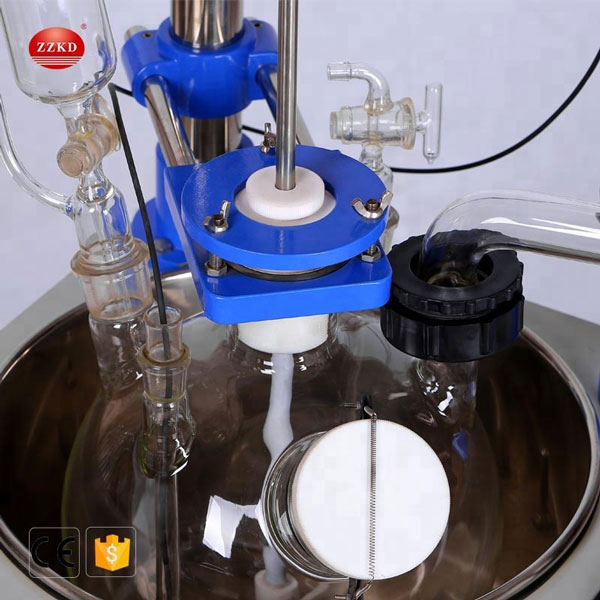Chemglass 20 l Jacketed Glass Reactor Supplier
Product Description:
50 l jacketed glass reactor and equipment are designed to be utilized for various chemical activities that involve chemicals such as specialty chemicals, pharmaceutical drugs, agricultural products, and polymers. This is because an advantage of glass is its ability to be resistant to the harsh effects of many chemicals such as corrosion. Its anti-stick surface makes it easy too clean and eliminates the risk of impurities entering the chemical activities it handles.
However, these 20 l jacketed glass reactor and equipment can be prone to many faults and defects that are usually due to manufacturing or mechanical problems and thermal shocks. These issues can be mitigated and avoided by following a rigorous safety procedure so that you and your personnel do not have to experience the consequences of dangerous glass reactor operations. Below are some examples of how you can ensure safety when handling chemglass 20l jacketed reactor and equipment.

Different types of chemical glass reactors.
A chemical reactor provides a simple enclosed space in which chemical reactions take place. In this case, however, chemglass 20l jacketed reactor are dedicated to a wide range of processes in industry. These reactions include crystallization, solid dissolution and polymerization, among others. 1l Jacketed Reactor, including a glass vessel with agitator and a central cooling or heating system, depending on the application. There is no standard size for these vessels as these reactors serve different purposes. Unlike other reactors, chemglass 20l jacketed reactor are very durable and versatile. The fact that glass is a transparent material gives them the upper hand because the user can see how the reaction is happening. Below are some of the types of glass chemical reactors that make the work of the chemical industry very efficient.
Types of chemical reactors
A jacketed glass reactor is a chemical glass reactor that operates in such a way that the innermost vessel holds all the reactants. At the same time the same part stirs the main elements, while the interlayer part introduces high temperature water and liquid while cooling the material. The main products supporting these types of reactor assemblies can also use multi-purpose auxiliary water circulation such as pumped circulation coolers, thermostatic circulators and closed refrigeration heating cycles.
Glass reactors of this type are very efficient in industry. Since it is made of solid borosilicate glass, it can withstand a wide temperature range from as low as 80 degrees Celsius to as high as 200 degrees Celsius. Also, the glass prevents any corrosion, making it very durable. With its transparent nature, visibility is easy and provides a digital display of high-speed mixing of chemicals. This reactor tends to work in a very stable manner because of its excellent physical and chemical properties. 20l jacketed reactor are available in a variety of designs and models to meet different needs.
Reactor Jacket Design
Rotatable lifting glass reactor.
It is a chemical glass reactor with a manual lift body that can easily facilitate bulk reactions. The kettle-like component is rotatable, ensuring users can easily clean it after completing an experiment. In addition, the vacuum in the reactor is higher, which means there is more room for stable movement of the reactants. Furthermore, since it has no dead ends, the reactor makes all mixing reactions efficient as it ensures no cross-contamination of the drug during the procedure.

Safety Considerations You Need To Pay Attention To When Using Chemical Glass Reactors:
DO:
1. Inspect the equipment upon arrival
2. Be aware of the vessel’s design limitations
3. Immediately flush spills with water
4. Neutralize surfaces after spills
5. Use plastic or PTFE-lined tools to scrape build-up of products
6. Wear clean rubber shoes when entering a vessel
DONT:
1. Extend equipment operation over the vessel’s design limitations
2. Use spark testers not recommended by the manufacturer
3. Lean over a vessel with items in your shirt pocket
4. Charge materials through nozzles with filtering the contents prior
5. Weld components on the interior or exterior of the equipment
6. Leave a manway cover open as it can accidentally fall and damage the glass
Though this is a guideline for how you can ensure you and your personnel’s safety in handling Single Layer Glass Reactor or equipment, it is important to remember that well-qualified technicians should conduct these inspections. Nonetheless, safety procedures are for everyone, and if you want to avoid any detrimental problems in the future, then you should practice these safety procedures, inspection programs, and tips in mind.
The main components of this reactor include the reactor, like the CNS, the vacuum and the stirring unit. The temperature unit also includes a helper reaction and a kettle body lifting unit. However, if you need more additional requirements, please always contact your manufacturer as they can easily customize it to suit your needs.
Also, 50l Jacketed Glass Reactor are more efficient in the chemical industry because they are easy to maintain and operate. Glass provides a smooth surface for the reaction. Still, they are eco-friendly and eco-safe because you can recycle them anytime.